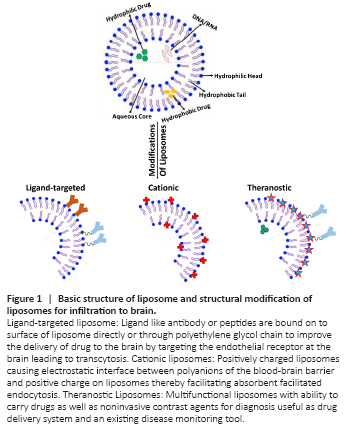神经退行性病
-
Figure 1|Basic structure of liposome and structural modification of liposomes for infiltration to brain.

Liposomes are spherical, organic nanoparticle formations, composed of lipid bilayer encompassing an aqueous core along with an impermeable exterior lipophilic phospholipid layer (Figure 1) (Ross et al., 2018; Harilal et al., 2019). The aqueous center is enclosed to envelope water-soluble agents for transport ensuring the arrival to the targeted areas (Sokolik and Maltsev, 2015). The aqueous intermediate allows for the polar segment of the molecule continues to stay in link with the polar environment, while still shielding the non-polar segment. The outer coating surrounding the aqueous center is made up of fat referred to as a phospholipid bilayer (Harilal et al., 2019; Mourtas et al., 2019). The bilayer phospholipid layer helps transports lipid soluble agents in lipid soluble layer of cell membrane (Figure 1). Conventional liposomes are typically containing biological phospholipids and lipids such as monosialoganglioside, 1,2-distearoryl-sn-glycero-3-phosphatidyl choline, egg phosphatidylcholines, and sphingomyelin (Yu et al., 2011; Bender et al., 2019). The method of liposomes formulation is one way to classify distinct forms of liposome vesicles (Harilal et al., 2019; Mourtas et al., 2019). The liposomes can be classified into three groups; multilamellar vesicles (MLVs), small unilamellar vesicles (SUVs), and large unilamellar vesicles (Corace et al., 2014; Dreier et al., 2016; Kong et al., 2020). The MLVs are made up of numerous lipid layers divided by an aqueous solution; the preparation is spontaneous. MLV are formed by gentle shaking. Small unilamellar vesicles or large unilamellar vesicles vary in size and are created from homogenization of MLV with a single lipid layer (Varghese, 2005; Kassem et al., 2020). Liposomes are entailed of cholesterol plus phospholipid and active drug molecules (Ostro and Cullis, 1989; Vermunt et al., 2019). The location of drug encapsulation is determined by the drugs optimal environment. Understanding the liposomes phospholipid make up allows for a better understanding of the drug’s necessary location for transport. The phospholipid is made up of a hydrophobic tail (2 fatty acids containing 10-20 carbon atoms), and a hydrophilic head (phosphoric acid bound to a water-soluble molecule) (Harilal et al., 2019; Fonseca-Gomes et al., 2020). The lipid can range in size from 25 nm to 5000 nm microscopic fatty material. Therapeutically liposomes can increase a drug’s efficacy, stability, control release, administration via multiple routes, targeted tissue action, and assist in the reduction of unnecessary drug toxicity (Corace et al., 2014; Dreier et al., 2016; Fonseca-Gomes et al., 2020). Liposomes have been long studied as vesicles that can be engineered to offer appeal to endogenous barriers prone to turn away foreign objects (Yadav et al., 2017).